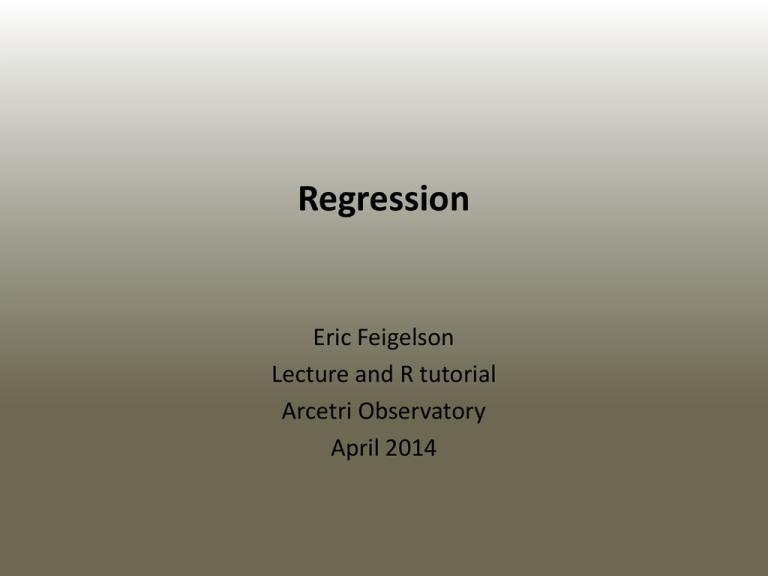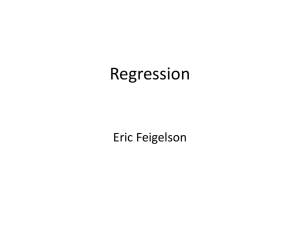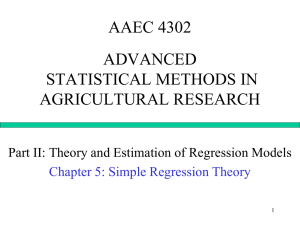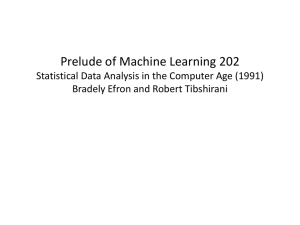4_Regression
advertisement

Regression Eric Feigelson Lecture and R tutorial Arcetri Observatory April 2014 Regression vs. density estimation Density estimation is nonparametric: no functional form for the shape of the distribution, or relationship between the variables, is assumed. It is usually applied to 1- or 2-dimensional problems. Regression differs in two respects: • It addresses problems where one seeks to understand the dependency of a specified response variable Y on one (or more) independent variables X (or X). • It addresses problems of modeling where the functional form of the relationship between the variables is specified in advance. The function has parameters, and the goal of the regression is to find the `best’ parameter values that `fit’ the data. Astronomers perform regressions with heuristic functions (e.g. power laws) and with functions from astrophysical theory. Classical regression model: ``The expectation (mean) of the dependent (response) variable Y for a given value of the independent variable X (or X) is equal to a specified function f, which depends on both X and a vector of parameters q, plus a random error (scatter).” The `error’ e is commonly assumed to be a normal (Gaussian) i.i.d. random variable with zero mean, e = N(m,s2) = N(0,s2). Note that all of the randomness is in this error term; the functional relationship is deterministic with a known mathematical form. Warning Astronomers may be using classical regression too often, perhaps due to its familiarity compared to other (e.g. nonparametric) statistical methods. • If there is no basis for choosing a functional form (e.g. an astrophysical theory), then nonparametric density estimation may be more appropriate than regression using a heuristic function. • If there is no basis for choosing the dependency relationship (i.e. that Y depends on X, rather than X on Y or both on some hidden variables), then a form of regression that treats the variables symmetrically should be used (e.g. OLS bisector). The error term e There may be different causes of the scatter: • It could be intrinsic to the underlying population (`equation error’). This is called a `structural regression model’. • It may arise from an imperfect measurement process (`measurement error’) and the true Y exactly satisfy Y=f(X). This is called a `functional regression model’. • Or both intrinsic and measurement errors may be present. Astronomers encounter all of these situations, and we will investigate different error models soon. Parameter estimation & model selection Once a mathematical model is chosen, and a dataset is provided, then the `best fit’ parameters are estimated by one (or more) of the techniques discussed in MSMA Chpt. 3: • • • • • Method of moments Least squares (L2) Least absolute deviation (L1) Maximum likelihood regression Bayesian inference Choices must be made regarding model complexity and parsimony (Occam’s Razor): • Does the LCDM model have a w-dot term? • Are three or four planets orbiting the star? • Is the isothermal sphere truncated? Model selection methods are often needed: c2n, BIC, AIC, … The final model should be validated against the dataset (or other datasets) using goodness-of-fit tests (e.g. Anderson-Darling test) with bootstrap resamples for significance levels. Important! In statistical parlance, `linear’ means `linear in the parameters bi’, not `linear in the variable X’. Examples of linear regression functions: 1st order polynomial high order polynomial exponential decay periodic sinusoid with fixed phase Examples of non-linear regression functions: power law (Pareto) isothermal sphere sinusoid with arbitrary phase segmented linear Assumptions of OLS linear regression • The model is correctly specified (i.e. the population truly follows the specified relationship) • The errors have (conditional) mean zero: E[e|X] = E[e] = 0 • The errors are homoscedastic, E[ei2|X] = s2, and uncorrelated, E[eiej] = 0 (ij) • For some purposes, assume the errors are normally distributed, e|X ~ N(0,s2) • For some purposes, assume the data are i.i.d., (xi,yi) are independent from (xj,yj) but share the same distribution • For multivariate covariates X=(X1, X2,…, Xp), some additional assumptions: – Xi … Xp are linearly independent – The matrix E[Xi,Xi’] is positive-definite OLS gives the maximum likelihood estimator For linear regression A very common astronomical regression procedure Dataset of the form: (bivariate data with heteroscedastic measurement errors with known variances) Linear (or other) regression model: Best fit parameters from minimizing the function: The distributions of the parameters are estimated from tables of the c2 distribution (e.g. Dc2 = 2.71 around best-fit parameter values for 90% confidence interval for 1 degree of freedom; Numerical Recipes, Fig 15.6.4) This procedure is often called `minimum chi-square regression’ or `chisquare fitting’ because a random variable that is the sum of squared normal random variables follows a c2 distribution. If all of the variance in Y is attributable to the known measurement errors and these errors are normally distributed, then the model is valid. However, from a statistical viewpoint …. … this is a non-standard procedure! Pearson’s (1900) chi-square statistic was developed for a very specific problem: hypothesis testing for the multinomial experiment: contingency table of counts in a predetermined number of categories. where Oi are the observed counts, and Mi are the model counts dependent on the p model parameters q. The weights (denominator) are completely different than in the astronomers’ procedure. A better approach uses a complicated likelihood that includes the measurement errors & model error, and proceeds with MLE or Bayesian inference. See important article by Brandon C. Kelly, ApJ 2007.











